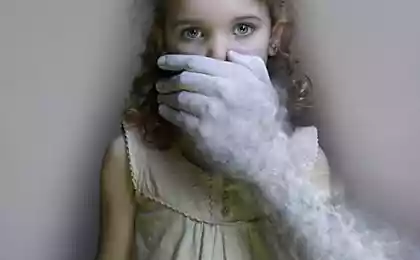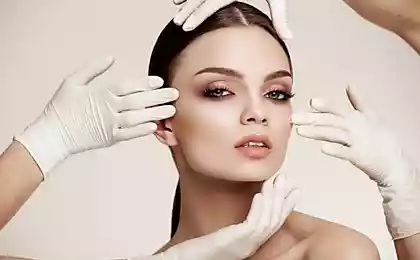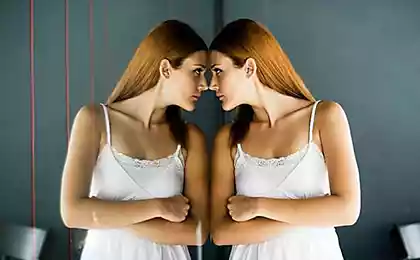1381
Icy Beauty
Blue River, the glaciers of Greenland

This is an amazing blue river formed by melting glacier in Greenland, Petermann, who filled the low-lying area of blue water. Places filled with water vary seasonally, every time alters the shape of the river. Bright blue color formed by glacial silt.
Ice waterfalls, Svalbard (Spitsbergen)

Svalbard, or as it is called Svalbard - an archipelago in the Arctic, which is in the northern part of the Kingdom of Norway. Despite the proximity to the North Pole, Svalbard relatively warm place due to the influence of the Gulf Stream. It is a large area of the island, which is 60 percent covered by glaciers.

Some of these glaciers are formed by small waterfalls from melting snow and ice, which can be seen in the warmer months. Huge glacier Bråsvellbreen located on the second largest island - Northeast Earth 200 km is covered with hundreds of waterfalls melting.
Ice Cave, the island of Iceland


This amazing cave Svínafellsjökull lagoon in Iceland was established volcano Vatnajökull ice cap in the national park Skaftafell. Beautiful blue color was formed as a result of the fact that for centuries the ice compacted, squeezing all the air. Due to the lack of air in the ice, it absorbs a lot of light, and the cave now has a unique texture and color.
It is safest to visit the ice cave in the winter, and for better visibility - after a period of rain. Many of those lucky enough to be inside the cave, heard cracking sounds. However, these sounds do not arise from the fact that the glacier may collapse, and because it is constantly moving.
Briksdalsbreen, Norway


Briksdalsbreen - one of the most famous glaciers Jostedalsbreen bag-large glacier, located in Norway.
He ends with a small glacial lake, located at 346 meters above sea level.
Tourists from around the world come to admire briksdalsbreen located among the waterfalls and high mountains.
Ice Canyon, Greenland

This Ice Canyon in Greenland depth of 45 meters was created by melt water as a result of global warming. As can be seen the rim line which show layers of ice and snow formed over many years.
The dark deposits at the bottom of the channel - a cosmic dust, silty material resulting from weathering. It is deposited on snow, glaciers and ice caps.
Glacier "elephant foot", Greenland
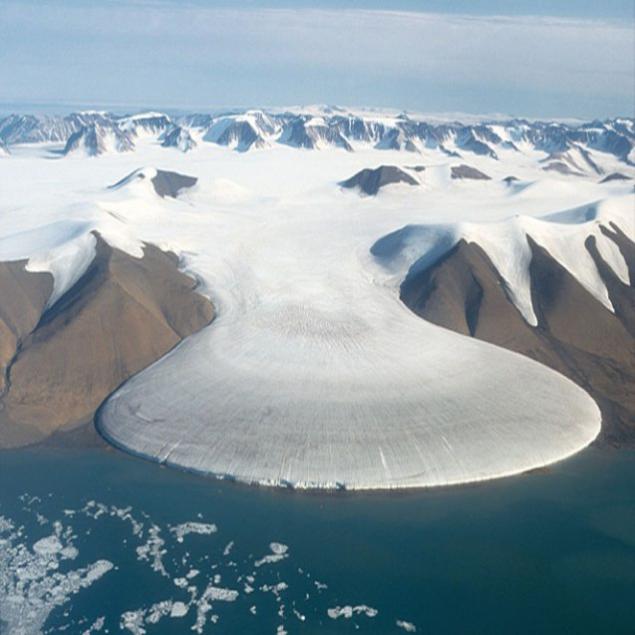
This huge glacier called "elephant foot" is located in the northern part of Greenland. The gray area in the lower part of the glacier - melting zone, which was formed by meltwater channels. Almost perfect round shape of the glacier has a diameter of about 5 kilometers.
Frozen waves, ice floes of Antarctica


Although at first glance it may seem that in front of you a huge wave, which is frozen, it is not formed by water wave.
In fact, this blue ice, which is formed when the compressed air bubbles are forced out. Ice appears blue since when light passes through it a thick layer, the blue light is reflected and absorbed by the red.
Himself ice formed over time, and repeated freezing and thawing gave the formation of a sleek look.
Striped iceberg, Southern Ocean

This phenomenon is most commonly seen in the Southern Ocean. Striped Icebergs can have blue, green and brown stripes formed when large pieces of ice breaking away from ice shelves and fall into the ocean.

For example, blue stripes were formed when the ice caps melt filled with water and frozen so fast that it did not manage to form bubbles. Salt water containing algae can lead to the creation of green stripes. Other colors usually appear when the rain picked up a layer of ice as he falls into the water.
Icy tower volcano Mount Erebus, Antarctica
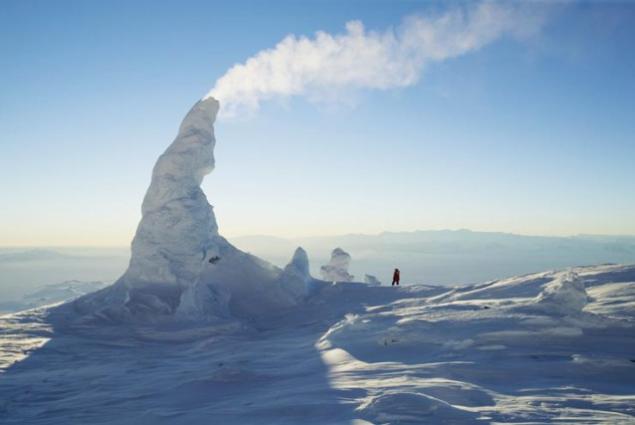
Constantly active volcano Mount Erebus - is perhaps the only place in Antarctica, where there are fire and ice. Here, at an altitude of 3800 meters, you can find hundreds of ice towers reach up to 20 meters in height. They often give off steam, part of which is frozen inside the towers, expanding and extending it.
Frozen waterfall

We tend to think that the waterfalls are majestic flow of water, but what would happen if suddenly frozen waterfall.
For example Falls Fang in Vail in the US turns into a huge pillar of ice in a particularly cold winter, reaching 50 meters high and 8 meters wide.
"Penitent snow," the Andes Mountains


Kalgaspory or as they are called "penitent snow" or "penitent monks" - is an amazing ice spikes, which are formed on the plains in the highlands such as the Andes Mountains, which are located at an altitude of 4000 meters above sea level.
Kalgaspory can reach a height of a few centimeters, resembling a frozen grass, and up to 5 meters, giving the impression of an ice forest.
It is believed that they were formed due to the strong wind in this area and sunlight, which causes uneven thawing of the ice and gives rise to strange shapes.
Kungur Ice Cave, Russia

Kungur Ice Cave - one of the largest caves in the world and the most amazing wonders of the Urals, which is located on the outskirts of Kungur in Perm region. It is believed that the cave for more than 10 thousand years.
Its total length is 5700 meters inside the cave 48 caves and 70 underground lakes with a depth up to 2 meters. The temperature inside the ice cave ranges from -10 to -2 degrees Celsius.
©

This is an amazing blue river formed by melting glacier in Greenland, Petermann, who filled the low-lying area of blue water. Places filled with water vary seasonally, every time alters the shape of the river. Bright blue color formed by glacial silt.
Ice waterfalls, Svalbard (Spitsbergen)

Svalbard, or as it is called Svalbard - an archipelago in the Arctic, which is in the northern part of the Kingdom of Norway. Despite the proximity to the North Pole, Svalbard relatively warm place due to the influence of the Gulf Stream. It is a large area of the island, which is 60 percent covered by glaciers.

Some of these glaciers are formed by small waterfalls from melting snow and ice, which can be seen in the warmer months. Huge glacier Bråsvellbreen located on the second largest island - Northeast Earth 200 km is covered with hundreds of waterfalls melting.
Ice Cave, the island of Iceland


This amazing cave Svínafellsjökull lagoon in Iceland was established volcano Vatnajökull ice cap in the national park Skaftafell. Beautiful blue color was formed as a result of the fact that for centuries the ice compacted, squeezing all the air. Due to the lack of air in the ice, it absorbs a lot of light, and the cave now has a unique texture and color.
It is safest to visit the ice cave in the winter, and for better visibility - after a period of rain. Many of those lucky enough to be inside the cave, heard cracking sounds. However, these sounds do not arise from the fact that the glacier may collapse, and because it is constantly moving.
Briksdalsbreen, Norway


Briksdalsbreen - one of the most famous glaciers Jostedalsbreen bag-large glacier, located in Norway.
He ends with a small glacial lake, located at 346 meters above sea level.
Tourists from around the world come to admire briksdalsbreen located among the waterfalls and high mountains.
Ice Canyon, Greenland

This Ice Canyon in Greenland depth of 45 meters was created by melt water as a result of global warming. As can be seen the rim line which show layers of ice and snow formed over many years.
The dark deposits at the bottom of the channel - a cosmic dust, silty material resulting from weathering. It is deposited on snow, glaciers and ice caps.
Glacier "elephant foot", Greenland

This huge glacier called "elephant foot" is located in the northern part of Greenland. The gray area in the lower part of the glacier - melting zone, which was formed by meltwater channels. Almost perfect round shape of the glacier has a diameter of about 5 kilometers.
Frozen waves, ice floes of Antarctica


Although at first glance it may seem that in front of you a huge wave, which is frozen, it is not formed by water wave.
In fact, this blue ice, which is formed when the compressed air bubbles are forced out. Ice appears blue since when light passes through it a thick layer, the blue light is reflected and absorbed by the red.
Himself ice formed over time, and repeated freezing and thawing gave the formation of a sleek look.
Striped iceberg, Southern Ocean

This phenomenon is most commonly seen in the Southern Ocean. Striped Icebergs can have blue, green and brown stripes formed when large pieces of ice breaking away from ice shelves and fall into the ocean.

For example, blue stripes were formed when the ice caps melt filled with water and frozen so fast that it did not manage to form bubbles. Salt water containing algae can lead to the creation of green stripes. Other colors usually appear when the rain picked up a layer of ice as he falls into the water.
Icy tower volcano Mount Erebus, Antarctica

Constantly active volcano Mount Erebus - is perhaps the only place in Antarctica, where there are fire and ice. Here, at an altitude of 3800 meters, you can find hundreds of ice towers reach up to 20 meters in height. They often give off steam, part of which is frozen inside the towers, expanding and extending it.
Frozen waterfall

We tend to think that the waterfalls are majestic flow of water, but what would happen if suddenly frozen waterfall.
For example Falls Fang in Vail in the US turns into a huge pillar of ice in a particularly cold winter, reaching 50 meters high and 8 meters wide.
"Penitent snow," the Andes Mountains


Kalgaspory or as they are called "penitent snow" or "penitent monks" - is an amazing ice spikes, which are formed on the plains in the highlands such as the Andes Mountains, which are located at an altitude of 4000 meters above sea level.
Kalgaspory can reach a height of a few centimeters, resembling a frozen grass, and up to 5 meters, giving the impression of an ice forest.
It is believed that they were formed due to the strong wind in this area and sunlight, which causes uneven thawing of the ice and gives rise to strange shapes.
Kungur Ice Cave, Russia

Kungur Ice Cave - one of the largest caves in the world and the most amazing wonders of the Urals, which is located on the outskirts of Kungur in Perm region. It is believed that the cave for more than 10 thousand years.
Its total length is 5700 meters inside the cave 48 caves and 70 underground lakes with a depth up to 2 meters. The temperature inside the ice cave ranges from -10 to -2 degrees Celsius.
©
















